What a Circuit Breaker Timer Does and Why It is Important?

Strong 8k brings an ultra-HD IPTV experience to your living room and your pocket.
A Circuit Breaker Timer is a testing equipment that measures the timing or duration of circuit breaker opening and closing during an electrical malfunction. This timing test is performed to protect electrical systems. It ensures the circuit breaker can immediately cease power flow and protect the electrical system. The timer tracks the reaction time, travel time, and other aspects of the breaker's performance.
Purpose of a Circuit Breaker Timer?
Circuit breaker timers provide proper functionality and quick response to overloads and short circuits. The timer counts how long it takes for the breaker's contacts to shift from closed to open, and vice versa. It also examines the travel duration, velocity, and other characteristics of the encounters. A circuit breaker's response time is crucial. If a breaker is too sluggish, it may fail to cease power flow in time to protect the electrical system.
How Do Circuit Breakers Work?
Your home's electrical service panel has a series of lever-operated circuit breakers that control and safeguard the circuits. Each circuit breaker is meant to 'trip,' or shut itself off, at preset amperage loads, which is why the box has different-sized breakers. To safeguard your house and family from fire and electrical injury, if this limit is reached, the breaker tripping opens the circuit and prohibits current passage to that specific electrical line or circuit.
Most Common Reasons Circuit Breakers Trip.
An overloaded circuit, such as a mother-daughter combat with hair dryers or your yearly Christmas light show.
A short circuit, such as a wiring fault in an appliance, causes extra current to be drawn.
A ground fault, which generally happens in high-moisture areas such as the kitchen and bathroom, is why GFCIs are needed by the current electrical code for your safety.
How Long Does it Take for a Circuit Breaker Timer to Operate?
Circuit breakers are essential components of all electrical power networks across the world. Engineers test circuit breakers regularly since they play such an important role. One of the most essential test procedures is the timing test, which determines the mechanical operating time of the breaker's contacts. This timing test is done using a circuit breaker timer. A timing test protects a circuit breaker since erroneous operation might have devastating effects on linked equipment and substation staff.
Various metering devices have emerged to determine the operating periods of a breaker. For example, although they are no longer in use, first-generation devices recorded curves in the oscillographic mode. The current form of testing, the second generation, is based on digital timers that convert pulses to time. The current approach for testing circuit breakers is to analyze signals from mechanical vibration.
Circuit Breaker Timer Operating Times
The technically operational quality of a three-phase circuit breaker is a significant feature in determining its operation times, the process of opening and shutting its contacts. The International Electrotechnical Commission's international standard, IEC 56.3.105, defines these time parameters. The standard quantitatively characterizes the process's on and off periods as follows:
The time difference between contacts is the diverging interval that characterizes the separation or connection of the breaker contacts during non-simultaneous switching.
Closing time is the period between energizing the closing circuit (with the circuit breaker in the open position) and when the contacts strike the poles.
The opening time of the breaker is the period between when the opening release is energized (the circuit breaker is closed) and when the contacts separate at all poles.
It is worth noticing the time difference between the breaker contacts. This should be within the given tolerance limits, which are generally 5 milliseconds. This is critical because the time delay between shutting down or opening all connections might result in massive voltage spikes that can destroy the network and its equipment.
Digital Timer Meter
Input circuits, a microcontroller, a display, and a keyboard are common components of digital timer meters. The microcontroller is the meter's primary unit, and the input circuit reduces disturbances and protects it.
The input circuit typically contains a converter with an output voltage of around 50 V. An opto-isolator enables optical isolation between the device's components that are directly linked to the breaker under test and the meter's other circuits. This safeguards components and digital circuitry, ensuring that the signal is standardised for further processing.
Circuit Breaker Timer: Principle of Operation
The measurement methodology is based on a principle known as the time pulse method. This enables the counting of pulses with a consistent frequency throughout time periods. The microcontroller's software enables the counting of pulses triggered by an external signal derived from the breaker's driving system.
The time gates close when a signal corresponding to the opening or closing of each breaker contact is received. As soon as the contact closure signals come, the microcontroller transfers the counter's contents into memory. The number of pulses counted by the microcontroller is proportional to the time gap between triggering and closing.
Conclusion
Circuit Breaker Timers are essential tools for testing and maintaining circuit breakers. Regular testing using this equipment may help fix problems and avoid future system breakdowns. If your home's circuit breaker frequently trips, it's critical to understand why so you can prevent it from happening again and protect yourself from electrical fires and injuries. In rare situations, the breaker itself may be destroyed, or you may be unaware of a damaged or malfunctioning appliance or an issue in the circuit itself, such as too many things on one breaker (also known as circuit overload). To avoid these problems, perform timing tests on the circuit breaker regularly.
Note: IndiBlogHub features both user-submitted and editorial content. We do not verify third-party contributions. Read our Disclaimer and Privacy Policyfor details.


